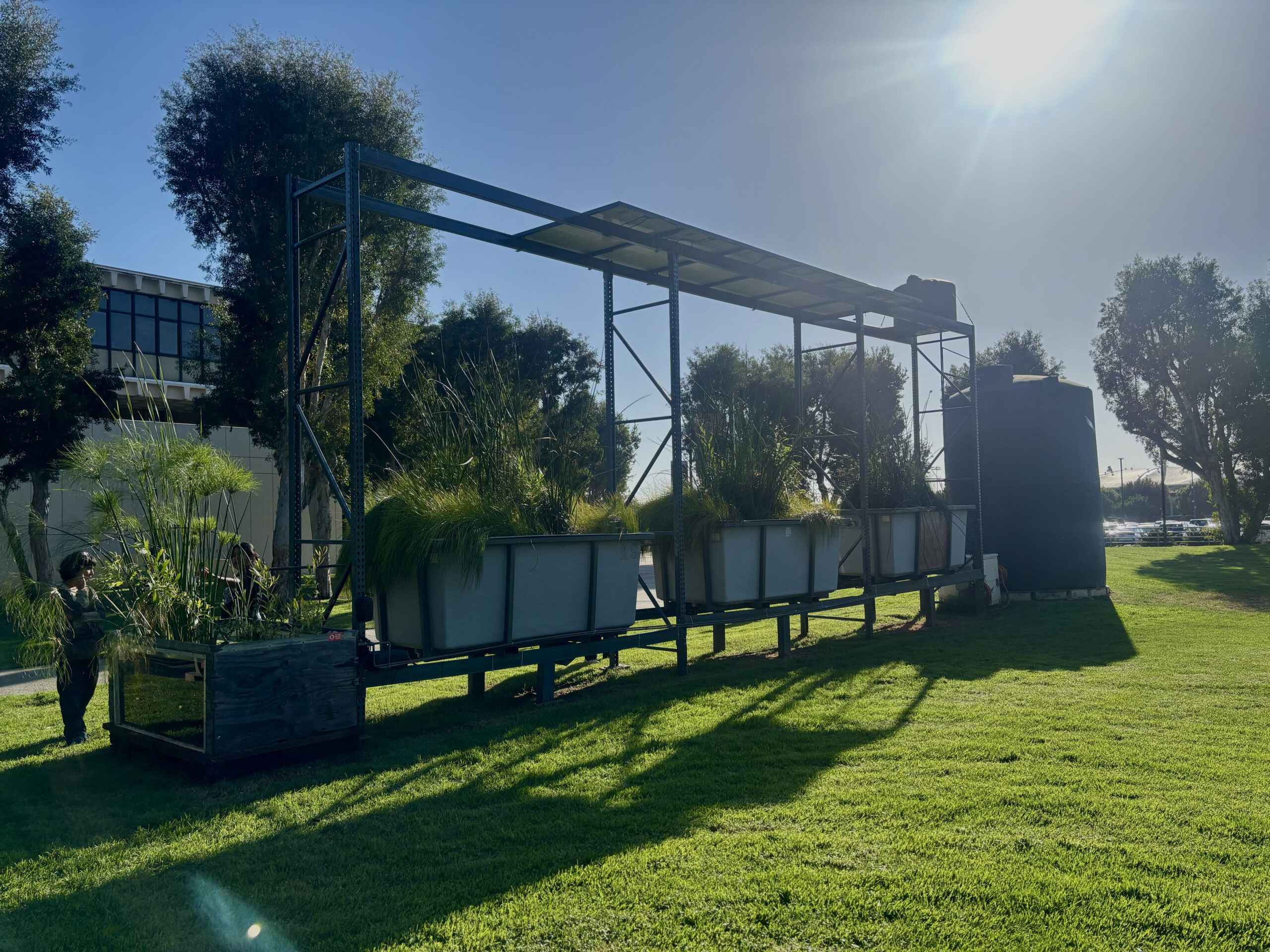By Viri Garcia Gallardo, Staff Reporter
Sculpture Garden installation offers blend of art, environmentalism, and local history
Toros walking past the 5,000-gallon tank set up on the lawn of the CSUDH Sculpture Garden are likely to hear a symphony of croaking frogs and flowing water. Don’t worry, though, Dominguez Hills is neither flooding nor overrun with amphibians – it’s just the Portable Wetland, a display symbolizing the ecosystems that once thrived on campus but are now vanishing.
The Portable Wetland is the centerpiece of Brackish Water, the latest showcase on display at the University Art Gallery. The exhibit explores the unique ecosystems of Southern California and the social movements that helped to shape the region. The 24-piece showcase features maps, artwork, and interactive displays, inviting observers to reflect on the connections between the environment, identity, society, and history.
Brackish Water a metaphor for Social Justice
Brackish water forms at the point where freshwater from rivers and lakes meets saltwater from the sea, creating a unique environment. This natural phenomenon serves as a powerful metaphor for the exhibit, symbolizing the convergence of different worlds. Brackish Water goes beyond environmental science by examining the nexus of local ecosystems, human infrastructure, and the historical injustices.
This blending serves as a powerful metaphor for the exhibit, symbolizing the convergence of different worlds. However, the exhibit goes beyond scientific exploration; it examines how these ecosystems intersect with human infrastructure and historical injustices. In particular, Brackish Water Los Angeles exhibit explores these issues through the lens of ecological racism and classism in the South Bay region.
A Mix of Science, History, Social Justice, and Art
At the heart of the exhibit are 24 pieces, with 21 located on campus – among them are maps from the early 1900s that expose the social divides of the time. The titles of some of the maps include racial slurs and pejoratives used to dehumanize Black Americans, illustrating the ways in which racist constructs have influenced geographical spaces. The aim is to challenge observers to confront uncomfortable truths about the environment and local communities.
“We wanted to create an exhibit that showcases the beauty of our local ecosystems while highlighting the historical injustices that have shaped our environment,” University Art Gallery co-director Aandrea Stang said. “It’s about making connections – between art and science, past and present, and people and nature.”
“It changes the way people think about repairing the earth,” said Portable Wetland contributor Millie Mason in an interview with The Bulletin.
Another piece by artist Alison Saar, titled “Sluefoot Slide,” explores themes of identity and belonging. According to Saar, the piece aimed to reflect what the renowned sociologist and essayist W.E.B. Du Bois once referred to as “two-ness” – the identity of being both American and Black – a parallel to the phenomenon of brackish water.
“This exhibit is a platform for conversation,” said Debra Scacco, co-director. “It challenges us to reflect on how we interact with our environment and each other.”
The Portable Wetland: a living prototype
The standout of the exhibit, the Portable Wetland, is a functional ecosystem prototype that employs innovative techniques to use recycled water and volcanic rock to filter and sustain plant life. According to Mason, the project contributor, environmentalism does not necessarily need to be expensive or reliant on technology.
“The plants and the bacteria are cleansing the water,” Mason said. “The earth will heal itself, as long as we allow the plants and bacteria to function.”
A Call to Action
Toros who have attended the Brackish Water showcase said they were amazed by the interactivity and richness of the exhibit. Junior Anahi Rodriguez Alvarez described the showcase as a “pretty cool and exciting experience.”
“I found the way they got the maps interesting,” Rodriguez Alvarez said “You can really feel the dedication and hard work that went into this project.”
Cassidy Carbonell, a senior,was impressed by how the exhibit used videos and sculptures to highlight themes. “The use of space, along with elements like sand and lights, creates a unique atmosphere,” Carbonell said.
Melenny Andrade, senior, said the exhibit helped her to reflect on the connections people have to the earth, and “the need to appreciate what the land is and take care of it.”
According to Stang, the university curator, inspiring stewardship on campus can make a positive, long-lasting impact. In this way, Brackish Water isn’t just an art showcase; it’s a movement for environmental change.

